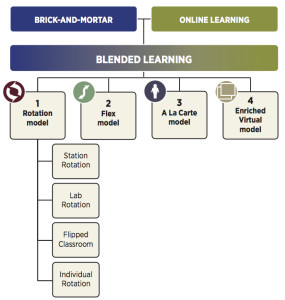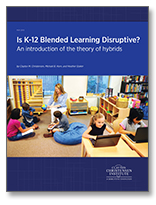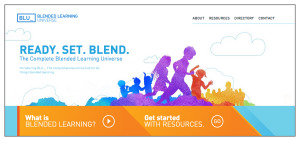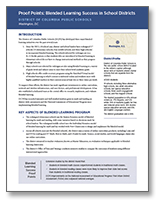What is blended learning?
Blended learning is not the same as technology-rich instruction. It goes beyond one-to-one computers and high-tech gadgets. Blended learning involves leveraging the Internet to afford each student a more personalized learning experience, including increased student control over the time, place, path, and/or pace of learning.
The definition of blended learning is a formal education program in which a student learns:
![]() at least in part through online learning, with some element of student control over time, place, path, and/or pace;
at least in part through online learning, with some element of student control over time, place, path, and/or pace;
at least in part in a supervised brick-and-mortar location away from home;
and the modalities along each student’s learning path within a course or subject are connected to provide an integrated learning experience.
What are the most common models of blended learning?
 The majority of blended-learning programs resemble one of four models: Rotation, Flex, A La Carte, and Enriched Virtual. The Rotation model includes four sub-models: Station Rotation, Lab Rotation, Flipped Classroom, and Individual Rotation. This taxonomy will evolve as the practice of blended-learning matures. Read the definitions of the models and sub-models here.
The majority of blended-learning programs resemble one of four models: Rotation, Flex, A La Carte, and Enriched Virtual. The Rotation model includes four sub-models: Station Rotation, Lab Rotation, Flipped Classroom, and Individual Rotation. This taxonomy will evolve as the practice of blended-learning matures. Read the definitions of the models and sub-models here.
Blended Learning Universe
The Blended Learning Universe—or BLU—is a comprehensive online hub packed with blended-learning resources. Whether you’re looking for a primer on the basics or want to dive deep into the supporting research, the BLU has you covered.
Curated by the Clayton Christensen Institute, the BLU offers a wealth of resources—including practical guides, video tutorials, and downloadable worksheets—and a searchable school directory of K–12 blended-learning programs worldwide. Our goal for this site is to provide meaningful information and tools for practitioners, policymakers, parents, and innovators—really anyone working to improve education through personalized, student-centered learning. Explore the BLU here.
Blended Learning MOOC
There’s plenty of buzz around blended learning and its transformational potential. But what does it really mean? You can now get the inside track on this growing movement by participating in our Blended Learning MOOC—a massive open online course—taught by our own Michael B. Horn, Brian Greenberg of Silicon Schools Fund, and Robert Schwartz of the New Teacher Center.
The course is available on Coursera and Khan Academy and is free and open to anyone, anywhere. It is also available in Portuguese and Japanese.
Does blended learning work?
Many in the field pose the question, does blended learning work? The truth is, the efficacy of blended learning greatly depends on its specific implementation and the particular problem it is designed to solve. The more pertinent question we should ask is what blended-learning model works, with what software, for which students.
Blended Learning Publications
Proof points: Blended learning success in school districts
September 2015
We teamed up with the Evergreen Education Group to publish 12 case studies of how traditional school districts improved student learning outcomes after implementing blended learning. Each short profile highlights key details in the district’s blended-learning strategy, the edtech products used, and promising results in the form of test scores and graduation rates. Read more

Blended: Using Disruptive Innovation to Improve Schools
October 2014
Co-authored by Michael Horn and Heather Staker, Blended: Using Disruptive Innovation to Improve Schools serves as a design guide for K–12 stakeholders looking to effectively embrace the rise of blended learning. This book is a must-have resource for educators, parents, and innovators navigating the future of learning. Read more

Is K–12 blended learning disruptive? An introduction of the theory of hybrids
May 2013
This paper analyzes blended learning through the lens of disruptive innovation theory. It introduces the theory of hybrids and identifies sustaining and disruptive models of blended learning. Read more

Classifying K–12 blended learning
May 2012
This paper introduces a refined definition of blended learning and distinguishes blended learning from other education practices. It highlights four blended-learning models and sub-models that are appearing across the K–12 field and provides examples of schools and districts that have implemented them. Read more

The rise of K–12 blended learning: Profiles of emerging models
May 2011
This paper offers 40 brief case studies of organizations that are beginning to blend online learning with supervised brick-and-mortar settings. It also provides a snapshot of the technology tools these organizations are using and the policy changes they have identified as the most helpful to advance their work. Read more

The rise of K–12 blended learning
January 2011
This paper observes that online learning is sweeping across America, and it is no longer only a distance-learning phenomenon. Most of the growth is in blended-learning environments. As blended learning grows, it has the potential to transform America’s education system into one that offers more personalized-learning approaches for all students. Read more


